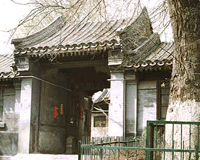
Work to preserve Beijing's historic streets and houses has begun, but the old imperial capital is still under threat, according to leading preservation experts.
The plate of No 1 siheyuan now hangs by the gate of the courtyard home at No 39, Dongsi 12th Lane.
However, when China Daily reporters called the municipal bureaus of cultural heritage and of city planning, no official would say which traditional courtyard is listed as No 2 or offer the addresses of the other 199 siheyuan.
Some precious courtyard houses still face demolition or destruction, said Liu Xiaoshi, a leading architect active in the preservation of old Beijing.
Liu, 80, was the director of the Beijing City Planning Bureau in 1980s, the predecessor of the current Beijing City Planning Commission which has the final say on which areas can be demolished.
China's registered cultural relics are divided into four levels -- state-level, provincial or municipal level, city level, and district or county level.
The 200 selected siheyuan are not listed among the registered cultural relics, Liu noted.
The few courtyard houses on the official registration list are homes of well-known historic figures.
But even listed cultural relics sometimes cannot escape destruction.
Yu Qian (1398-1457) Temple in Beijing is a case in point. It has been nearly ruined, even though it was added to the municipal-level protection list of cultural relics in 1980.
Yu Qian was the minister of defense in the early Ming Dynasty (1368-1644). Under his lead, Ming soldiers and people successfully defended the capital against the attack of Mongolian nomads in 1449. However, Yu was beheaded on the orders of the then Ming emperor, who accused Yu of putting his life in danger.
But people built the Yu Qian Temple in memory of Yu's courage.
Today, Yu Qian Temple is littered with debris and dissembled old furniture. The roofs of several rooms are holed and thick dust coats a wine-colored folding screen in a room at the rear of the complex.
A woman sitting outside the old courtyard said she was entrusted by the Beijing Bureau of Cultural Heritage to stop the house from being destroyed.
"Originally it was said the residence would be removed to build a new mansion, and now the cultural heritage bureau says it will be preserved and I was sent here to guard against thieves," said the woman, who only identified herself as Li.
Chen Zhihua, a professor of ancient architecture with Tsinghua University, said the wooden structure of the ancient rooms would be destroyed within one rainy season because of the holes in their roofs.
Officials from the municipal cultural heritage bureau said the temple would not be demolished, but the protection plan had not been finalized.
The race between bulldozers and conservation is a fierce one, despite the fact that top Beijing municipal officials have repeatedly called for ancient Beijing to be protected.
About 50 meters south of Yu Qian Temple lies a silent and delicate courtyard in which plants, rockwork, a bridge and small pond form a carefully devised garden.
However, on the wall of the 500-square-meter courtyard, the word chai (to be demolished) is clearly marked.
The courtyard, now the temporary home of the widow of a former minister, used to be the home of Tang Shaoyi (1860-1938), the first premier (Mar 1912-Jun 27, 1912) of the Republic of China. It is on the cultural relics protection list of Dongcheng District.
"We have been told that the courtyard will be demolished to build a luxury mansion," said the courtyard guard. "We cannot interfere with the development because this house is government-owned."
An official with Dongcheng District Bureau of Cultural Heritage said it is discussing with the developer of the luxury mansion how to protect the site. But they did not deny the courtyard home could be removed or rebuilt elsewhere.
In Xicheng District's Wudinghou Street, near the business hub Financial Street, residents are moving out of their ancestral homes. Courtyards here will be pushed down to build luxury apartments.
"We would not move, but we do not have any other choices," said 73-year-old Li, who shares with seven other households a big courtyard which used to be the residence of Yan Xishan (1883-1960), one of the top warlords of early last century.
Residents here will be compensated 8,600 yuan (US$1,038) per square meter of living area. However, with an average living area of less than 30 square meters, most households will only receive about 200,000 yuan (US$24,154) each while the new apartments built there will sell for at least 1 million yuan (US$120,772) each.
"Even if we do not talk about protection, residents should be compensated more. On the other hand, a higher and market-based compensation cost would curb developers' desire to destroy old houses," Liu suggested.
(China Daily August 13, 2003)
|

